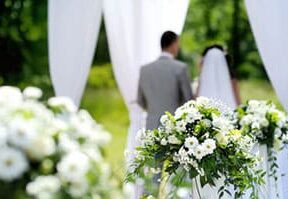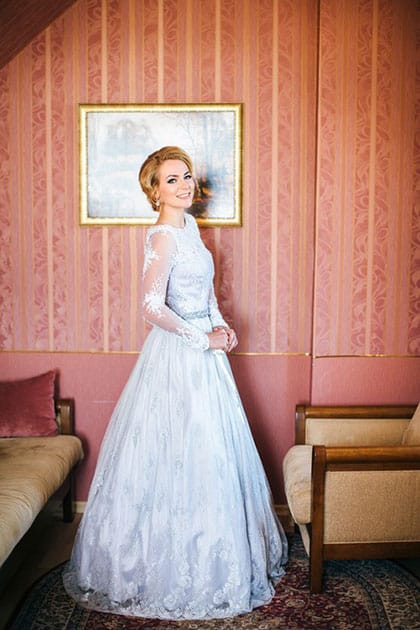
Jun 29
Find appropriate bridesmaids dresses – ideas for wedding
Bridesmaids dresses
White pantaloons and a mob cap, but this would not look so good on a 35-year-old matron of honour! Similarly, low-necked off-the-shoulder dresses look fine on older bridesmaids with good figures but would look inappropriate on small girls.
You may want to choose a basic style of dress that reflects the pattern of your wedding dress. This will help to give an overall homogeneity to the bridal party. Many ranges of off-the-peg bridal gowns have coordinating bridesmaids’ dresses available to complement them, and many sew-it-yourself patterns either have sister patterns for bridesmaids’ dresses or give instructions for making attendants’ dresses from the main bridal gown shape. Obviously this only works if your bridesmaids are the same size and shape as you are.
If your bridesmaids cover a wide age range, you can probably think up adaptations of a basic dress pattern that would suit all of the different ages. For instance, the basic pattern could be a style with a fitted bodice and a gathered skirt. The matron of honour and any older bridesmaids could wear dresses with low necks and off-the shoulder sleeves; teenage bridesmaids could wear the basic pattern with a scoop neck and puffed sleeves, and younger bridesmaids could wear dresses with a high neck and puffed sleeves. The younger bridesmaids’ hems could be knee-length instead of full-length.
For very young bridesmaids it is always sensible to keep away from floor-length hems; it is very easy for a small girl to trip over a long hem. Make the dress ankle-length, calf-length or knee-length. If your bridesmaids are very different shapes, make sure that you find a pattern that flatters them all. A heavy bridesmaid will feel ridiculous in a closely fitted and gathered dress, especially if she is with sylph-like counterparts.
Bridesmaids’ dresses – Fabrics/ Accessories/Checklist Fabrics
During the 50s and 60s satins were the rule for bridesmaids’ dresses, and were very suitable for the extremely simple princess styles and straight skirts of those eras. Since the advent of ‘flower power’ and subsequent fashion trends, dresses for both bride and bridesmaids have become much more feminine. As a result many more fabrics have been brought into use for bridesmaids’ dresses – prints, ginghams, cottons, slubbed silks, broderie anglaise, checks, etc. Choose a fabric that complements your wedding dress; for instance if you are all layers and layers of fine net and organdie, bridesmaids in tartan wouldn’t look very appropriate – or if you are in Edwardian style, bridesmaids in satin and net crinolines would look strange. Don’t just look in the ‘bridal’ departments of shops for fabrics and dresses; these tend to be very safe and predictable. Shop around in boutiques and the other departments, and you could come across just what you are looking for.
Accessories
Once again it is best to have accessories that complement your own in style; the bridesmaids’ bouquets, headdresses and shoes should all echo your own rather than clash with them. Shoes for older bridesmaids could be sandals, court shoes or satin slippers; shoes for younger bridesmaids could be pale party shoes or ballet slippers, or even patent leather shoes in a pretty style. As with your own shoes, make sure that all those of your attendants are non-slip!
Checklist for bridesmaids’ clothes
| Who are my bridesmaids going to be? | What fabric will be suitable? | |
| Should the fabric be plain or patterned? | ||
| Do we want any extra design features, such as tucks, bows, sashes, ribbons, flowers, frills, overskirt aprons, etc? | ||
| What colours) will they be wearing? | ||
| What headdresses will they wear? | ||
| Will this blend in with the rest of the wedding party? | ||
| Will their dresses reflect mine in style? | ||
| What shoes will they wear? | ||
| Will they be bought, made or hired? | ||
| II made, who will make them? Will the same person make them all? | ||
| What colour tights or socks will they wear? | ||
| Is there a chief bridesmaid? | ||
| If so, how will she be distinguished? | What jewellery will they wear with the dresses? | |
| Is the style flattering to all my bridesmaids? | ||
| Does the colour chosen suit them all? | When will the dresses be ready? | |
| Can they all wear the same style of dress? | ||
| If not, how can we adapt the basic style? | Who will look after the dresses until the day? | |
| Where will the bridesmaids dress for the wedding? | ||
| What length will the dresses be? |
 Bridesmaids’ dresses – Optional styles
Bridesmaids’ dresses – Optional styles
Styles for bridesmaids’ dresses
Bridesmaids’ dresses can come in almost any shape and colour; the styles shown here are just some of the many options.
1 Formal plain satin dress with fitted bodice, puffed and gathered sleeves and gently gathered skirt.
2 Ruffled dress with sash and puffed sleeves.
3 Gingham dress with broderie anglaise apron and mob cap.

4 Ruffled and frilled dress that could be made up in a plain or printed fabric.
5 Striped dress with leg-of-mutton sleeves and square neckline.
6 White dress with sash and underskirt in a contrasting colour.

7 Bride’s and bridesmaid’s dresses showing how the same basic style can be adapted. The bride’s dress has flowers along the neck ruffle and skirt, and a gathered overskirt that has been caught up with ribbons. The bridesmaid’s dress has a narrower neck frill and ruffle around the skirt.

8 Dresses for two bridesmaids of very different ages, made up in two shades of peach. Both dresses have gathered and ruffled sleeves and are trimmed with lace.
9 Matching bridesmaids’ dresses in white overlaid with spotted voile; these dresses would suit bridesmaids of any age from young girls to a matron of honour.






